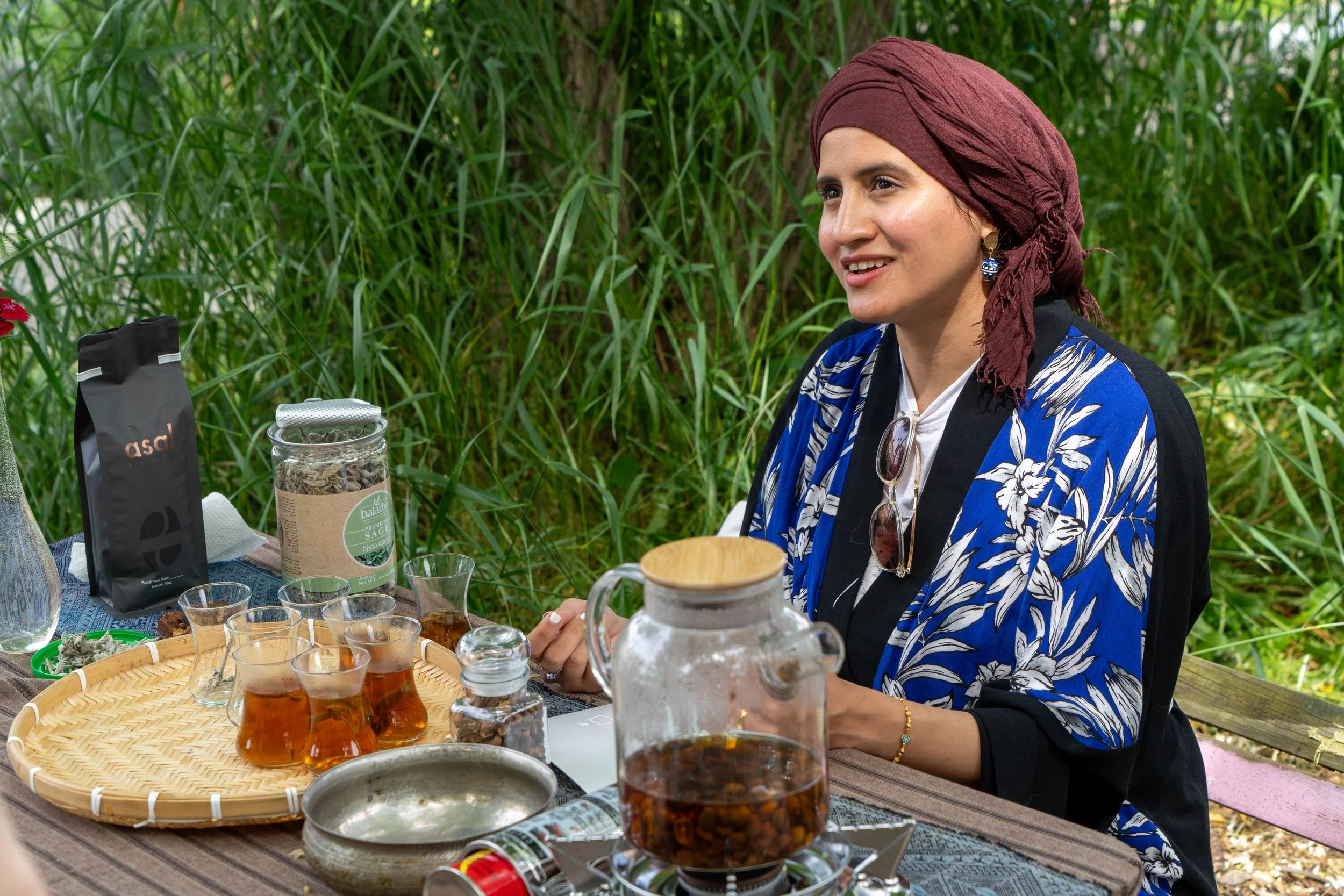Stories and a Cup of Qahwa
By Fifa Atef
Fifa is a writer and holistic nutritionist based in New York. After leaving home in Yemen because of the war, writing was a way for her to reflect on herself and things around her. If she isn’t spending her time writing, you can almost always find her in nature, reaking, hiking or enjoying tea witih friends and family.
Fifa Atef’s personal essay is one which straddles the connection of two beverages crucial to her experience in Yemeni culture. Often, we hear about the absurd battle of betweens: coffee vs. tea, dogs vs. cats, etc. We hope you will enjoy the scenic transportation to a village in Yemen where coffee and tea coexist.
During the war in 2015, my sister and I moved out of Sana’a, the capital of Yemen, as it was no longer safe. We stayed at my mother’s native village Wadi Marhab, where I spent most of my time with my grandmother whom I called Omi Ghafrah. During my time in the village, I learned how to live the simplicity of village life while seeking adventures in the surrounding mountains.
One day, we woke in the early morning, when it was still dark, and prepared for the day. Like most days, Omi would brew coffee in the kitchen, its smell permeating the house, before she and I sat in the backyard. We held glass tea cups with painted patterns of diamonds and stars; the inside was filled with light coffee and a pinch of powdered ginger. We talked about my dreams and what I hoped to do in the future, and how I would one day travel the world, visiting far off lands and meeting people of different cultures. We watched the sunrise paint hills and valleys, and eventually the many houses made of stone and brick that dotted the horizon. Dewdrops gathered along trees so close that we watched them sway to the morning breeze as Arabian Babblers and tiny Black Redstarts chirped. The roosters left their chicken huts and called cock-a-doodle-doo, waking the farmers who had been working so hard the day before. Donkeys, cows, and sheep grazed the hillsides. Smoke eventually emerged from houses, as breakfasts were cooked over fires.
Photo @ Fifa Atef
Our breakfast would include losah bread baked from a clay tanoor oven, milk fresh from the family’s cow, some vegetables, and hot gee. After we finished, we cleaned the dishes and swept the yard and entire house, mopped the kitchen, and fed the farm animals. We were accompanied by radio stations that played traditional songs filled with qanbus/turbi, drums, and ouds. This included famous Yemeni singers such as Ayoob Tarish, Fuad Al-Kebsi, and Najiba Abdullah–all singers that not only I grew up with, but so did my mother and grandmother. My favorite style of Yemeni songs was “Al-Ghina al-San'ani,” as they were uniquely poetic.
When we had finished, Omi and I decided to go on a hike to the highest mountain top in our village. On our way there, we were greeted by neighbors leaving their homes to work on their farms. The hills were as dotted with trees and cactuses as ever, and we had to be careful of where we walked.
When we reached the top of the mountain, we sipped our victory of qahwa in our respective thermoses. As we rested, we talked about the things I had learned in school, such as social studies and history. After I told my grandmother about the Ottoman Empire and how they had taken control of the mountain ranges that were near the village, she told me the story that her father had told her of how qahwa was invented.
Photo @ Fifa Atef
When the Ottoman empire in the 1960’s exported coffee beans from Northern Yemen to the world, Yemenis kept the outer shell of the beans. They didn't consider it a waste like the empire did, but instead recycled the husk and preserved it to be sold in the local market. Each city had a unique method of making qahwa; some groups crushed the husk into a powder mixed with regional spices while others used the most common way of brewing the husks whole.
Drinking qahwat alqishr is a Yemeni tradition that has lasted decades. As Omi Ghafrah told the story, I felt pride in how my ancestors had been able to create such a delicious drink from what others viewed as disposable and unusable.
Later that afternoon, friends and neighbors visited my grandmother's house and brought with them homemade dishes and desserts. Some even brought their own cups to drink from. They would have unstoppable sips of qahwa and tea, shared stories, played music, and danced throughout the day. In the evening, guests would say their goodbyes and leave, taking their empty pots and cups with them. After the last friend bid their long farewell, our family would have dinner with a thick and milky Yemeni tea called shahi haleeb. Alongside tea, my aunt would bring popcorn and dates to the table.
To make the tea, Omi boiled water over the fire in a kettle, then added sugar, cardamom, and Al-Kbous black tea. After letting it boil for a few minutes, the last ingredient to add would be condensed milk. It was always delicious, light, and it had a strong sweet smell of cardamom.
The first sip warmed my heart with joy; it reminded me how tea would always bring us together. Time seemed to slow down as I sunk into my seat; it had been a long while since I had felt so much at peace. My mind drifted to my parents, my mother would make similar tea when we would come home from a long day at school, where we would tell her all about the adventures we had with our friends. It seemed so long ago, yet the smell of the drink Omi Ghafrah had made, took me back to the safety and warmth of my childhood home where the weather in the mountains was usually cold and windy, and we appreciated having a hot drink in our hands.






